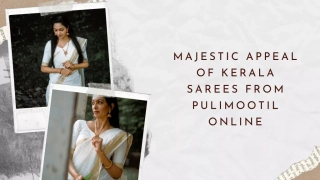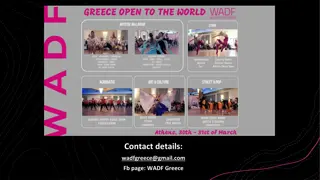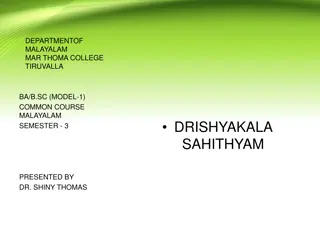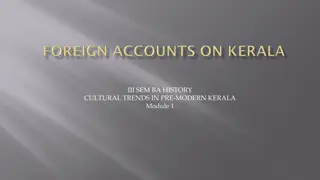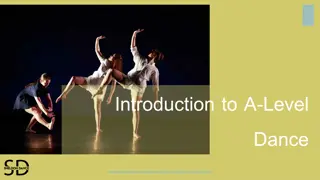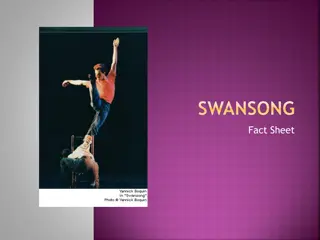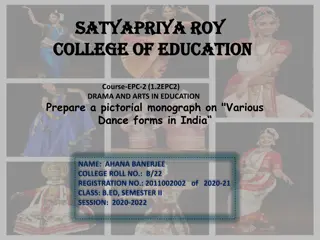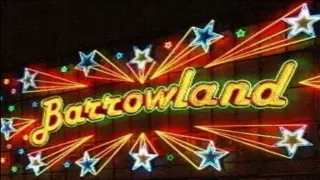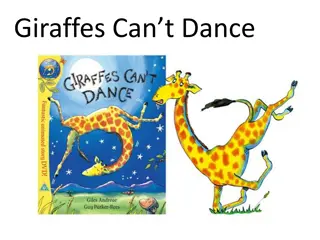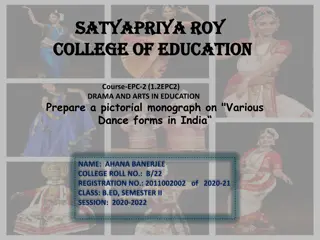Exploring Kathakali Dance: A Traditional Art Form from Kerala
Kathakali is a traditional dance form from Kerala, characterized by elaborate makeup, costumes, intricate movements, and expressive storytelling. Originating from ritual dramas, Kathakali combines acting, dance, enactment, music, and instrument accompaniment. Performances are conducted at night and early morning, showcasing the incredible skill and physical stamina of dancers trained in Kalaripayattu, the ancient martial art of Kerala. The makeup and costumes of characters play a significant role in portraying different roles in Kathakali.
Download Presentation

Please find below an Image/Link to download the presentation.
The content on the website is provided AS IS for your information and personal use only. It may not be sold, licensed, or shared on other websites without obtaining consent from the author. Download presentation by click this link. If you encounter any issues during the download, it is possible that the publisher has removed the file from their server.
E N D
Presentation Transcript
Course Name Drama and art in education (2ndSemester) Course code 1.2.EPC2 Title : Kathakali Dance (The art of dance) (Unit-3) By Shiuli Mahapatra
INTRODUCTION KATHAKALI , a form of ritual drama originated in Kerala. Evolving from earlier forms of dance drama such as KODIYATTAM,KRISHNATTAM,RAMANATTAM. It was performed in palaces and temples and at religious festivals. KATHAKALI draws its subject matter from the Hindu epics chronicling the lives , loves and conflicts of the Gods and heroes of indian mythology like Ramayana , Mahabharata , Puran. .
ETYMOLOGY The Name KATHAKALI derives from Malayalam words Katha which means story and Kali which means play.
ELEMENTS KATHAKALI is consideres to be a combination of five art forms like - 1.Natyam (Acting) 2.Nritham(Dance) 3.Nrithyam (Enactment) 4.Sangeetham (Music) 5.Vadyam (Instrument accompaniment)
PERFORMANCE A conducted at night and ends early in the morning. Kathakali is usually performed a kalivilakku ( kali = dance; vilakku = lamp), which provided light when the plays were performed inside temples, residences of nobles, Kathakali performance scheduled to begin at 10:00 pm will be announced in a special manner by the loud playing maddalam (percussion), elathalam and chengila (m etallic cymbals) during the evening, so that they can be heard even at a distance. This instrumental music, called kelikottu, is very familiar to lovers of Kathakali. traditional Kathakali performance is usually in front of and palaces. A of chenda,
ACTING A Kathakali concentration, skill, and physical stamina, gained through training based on Kalaripayattu, the ancient martial art of Kerala. Training begins around the age of ten, and often lasts for eight to ten years. The training program is intensive; each day begins at 3:30 am and ends at 8:30 pm, with short breaks in between. During the monsoon and winter there are rigorous body massage sessions. Each student learns the complete language of Kathakali, memorizing the combinations of facial expressions (rasas), bodily movements and hand gestures (mudras). Dancers also undergo special practice sessions to learn movements. actor needs immense powers of control of their eye
MAKE UP & COSTUMES There are five main types of characters, usually identified by the predominant color of makeup applied to the face or its pattern: 1. pacha 2. kathi 3. thadi 4. kari 5. minukku
PACHA In Kathakali, the pacha vesham with its predominant green colour is used to portray characters like kings and divine beings. These characters have a mix of satvic (pious) and rajsik (kingly) nature. Characters like Lord Krishna and Lord examples of pacha vesham. noble male Rama are
KATHI Kathi charecters are proud , aggressive and charecters such as demon king Ravana are though their make-up is basically green, denoting that they are high born, a red mark line on upturned moustache.They also have white knob on the tips of thin nose and on their foreheads. unrighteous
THADI There are three varities of thadi . The most aggressive demonic known thadi (red beard).Mythical and fabulous being like Bali (King of monkeys) are known as vella thadi (white beard), aboriginals, forest-men and are known as (black beard). and as chuvanna cave Karutha dwellers thadi
KARI The lowest and aggressive being are kari. It have small patterns of red , white and yellow on a black face. completely
MINUKKU It is used to represent women and sages.In female character performed by vesham is used to represent gentleness and high spiritual standing and is charecterized with yellow facial paint.. Kathakali the also are man.The
The costumes of the Kathakali dance are matched with the make-up.Some of the example of the dresses are given below- Head gear - Kirtam Ear rings Tora Small ear rings Chetipuru Red cloth are used below the head gear Chuttitan False hair Chamaram Wooden bangles Tolput Necklace of beads Kajuharam Ghaghra uruteketta Ghungur of kathakali dance Gochamoni Ladies scarf - Uruman
REFERENCE oDrama and art in education Aniruddha Mukherjee oKathakali Wikipedia owww.newworldencyclopedia.org/entry/kathakali ohttp://ccrtindia.gov.in/kathakali.php If you have any queries, please contact at Phone number 9732969846 Whattsapp no - 9800301705



